
From the SMH:
Holden chairman and managing director Mike Devereux says Holden will have to slash its labour costs in order to keep operating in Australia.
Devereux says Holden must make “significant labour related annual cost savings”, and that “every single option is on the table”.
Devereux did not directly say whether workers will have to choose between redundancy or a pay cut during talks in August, only that “employees will be presented with a very difficult decision”.
Speaking at a media conference this afternoon Devereux said current wage levels were not sustainable if the car maker is to continue producing the Commodore and Cruze until at least 2022.
The Holden boss says Australia’s manufacturing environment costs General Motors an extra $3750 per car to build vehicles here rather than importing them.
“Our manufacturing costs are simply too high,” he says.
“We’re talking to people about achieving labour-related savings in our costs per car.
“We can’t continue to make cars in Australia if we’re not competitive and can’t reduce those costs.
“The worst thing we can do is to ignore the realities and pretend that they don’t exist.”
The unions as well as the South Australian Premier don’t agree, from the AFR:
Union leaders and the South Australian Premier will oppose a GM Holden push for 1700 of its employees to take pay cuts to save the company’s unprofitable plant in Adelaide, a request experts said marked a historic moment in Australian manufacturing.
The secretary of the Australian Council of Trade Unions, Dave Oliver, said wages were too small a part of Holden’s costs to make an impact.
“I don’t subscribe to the point of view that cutting wages will be the only thing that saves Holden in Australia,” he said.
…
South Australian Premier Jay Weatherill said it was “not unknown” for an employer to want to change workplace practices but the government would not support a wages cut.
“Of course we don’t. We think workers should not face reductions in their terms and conditions of employment, but it is a matter for Holden to have a negotiation with their workforce,” he told Parliament.
The AFR editorial blames manufacturing:
This industrial culture is now colliding with the reality of Australian manufacturing. For generations, the foreign-owned car makers and their unionised workforces have conspired to fleece consumers and taxpayers. Now the mining boom’s strong dollar has exposed their high cost structure, they cannot hide behind an import tariff wall. And Canberra’s budget crisis means they cannot count on billions of dollars more in taxpayer handouts.
But this is wrong. This is not an issue that is restricted to manufacturing. As I reported earlier this week, mining FIFO wages are already falling much faster than $200 per week. That’s the key to understanding what’s going on. We’re entering Australia’s great labour cost reckoning which is itself only one dimension of Australia’s post-mining boom adjustment.
The story is simple enough. Three decades without a recession has made us too expensive to employ for global capital. We’ve staved off an adjustment via a housing and consumption boom then via the good fortune of a commodities boom. But both did the following to our competitiveness (as measured by the real exchange rate, charts courtesy of Ross Garnaut):
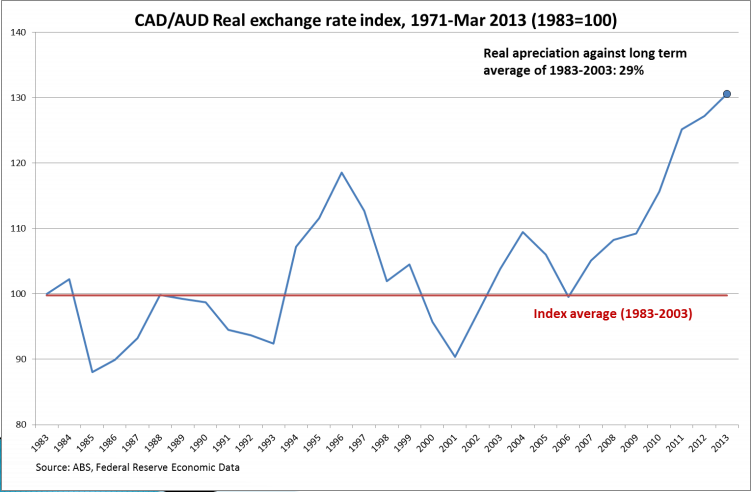
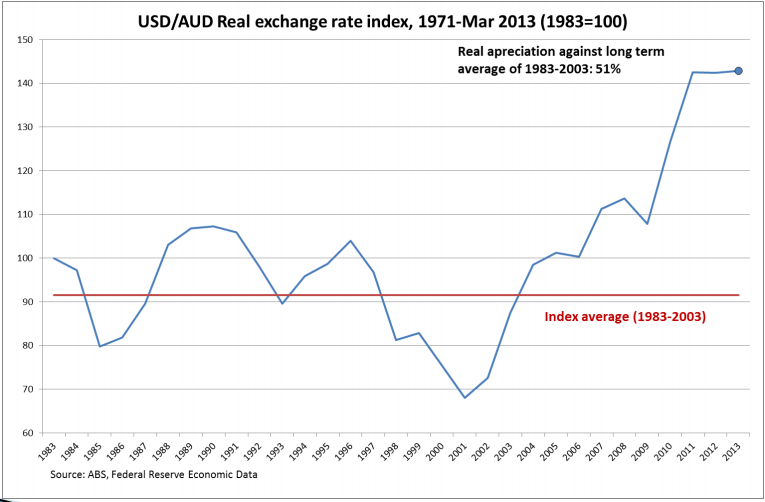
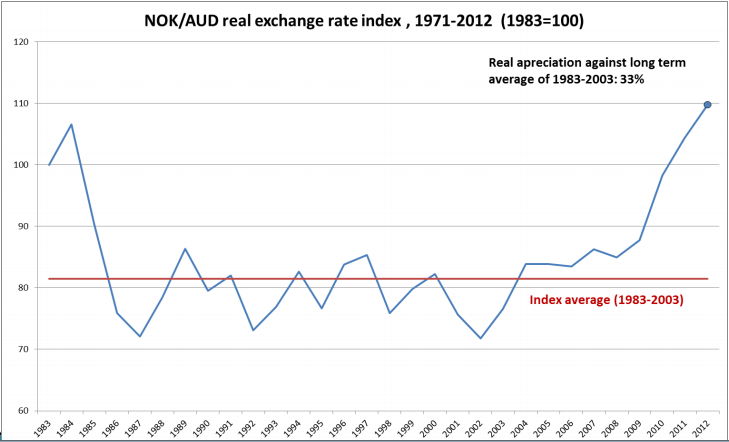
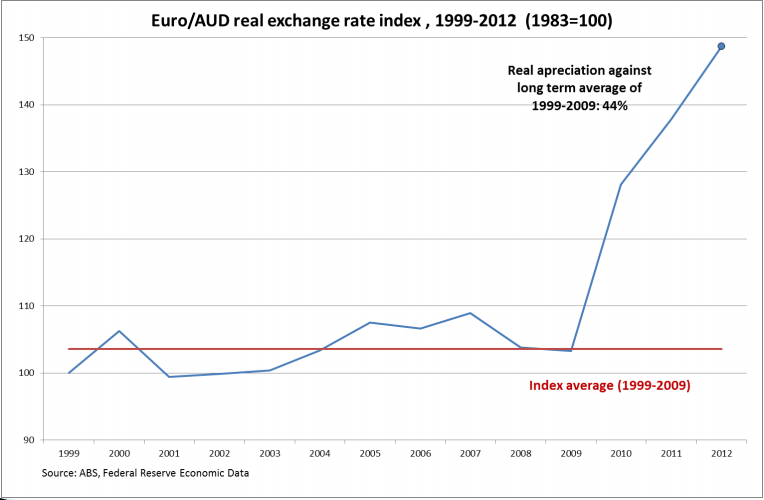

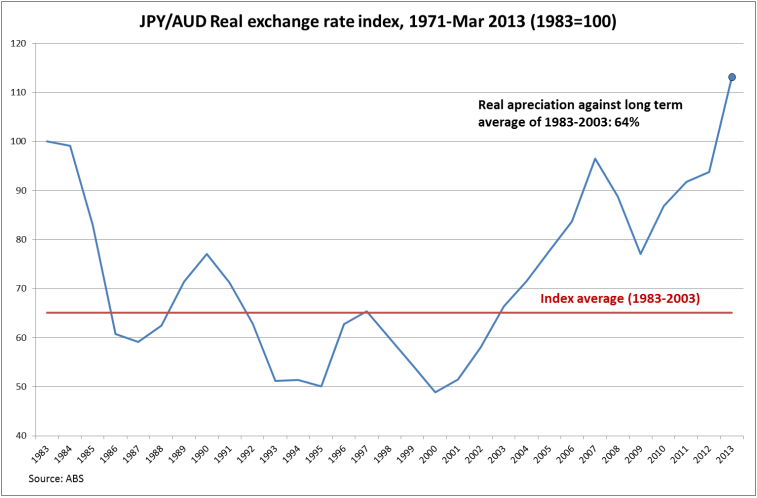
It’s not just manufacturing, it’s mining, it’s tourism, it’s education, it’s agriculture, it’s retail and even some services, it’s everything that is tradable. We can’t compete in any of it at this level of real exchange rate (which includes the currency and labour costs).
The correction has already begun thanks to an RBA that didn’t foresee it and has kept interest rates and the dollar too high for too long. The trend of swiftly falling wages growth is entrenched in the ABS’ wage price index:

But there is still time to catch up. There are a number of ways that the coming wage recession can be handled. In the recent past, Australia has adopted a kind of informal kurtzarbiet system in which workers cut hours rather than wages. Over the past year full time employment has barely grown while part time has surged. This is one reason why unemployment is rising only slowly even though in May aggregate hours worked was in recession, falling year on year:

But that system will not be enough to correct such a large imbalance as the mining boom ends. For that we will only have two choices. If we’re smart, a deal with unions will freeze wage hikes for an extended period, replicating the 1980’s wages accord that helped Australia recover competitiveness after the 1970’s mining boom. This can bring order to the process of adjustment (which will be 5-10 years) by allowing natural inflation to devalue wages as the dollar is forced down and corrects much of the nominal imbalance. It can also protect the most vulnerable at the bottom of the wages chain. This should be done via an explicit political narrative of burden sharing and top-down sacrifice. I have not seen any evidence yet that that is happening at Holden but could be wrong. Is Mike Deveraux taking a pay cut as well?
If we’re less smart, we’ll watch as the kind of mock libertarianism that has torn apart the US middle class will take hold here as well. That will be a process of industrial relations warfare, union destruction, rising unemployment and unbalanced wage correction from the bottom up as executives are protected by a loon pond business media that wears basic trickle down economics as a badge of honour.
Bizarrely, choosing which path of devaluation we wish to take is what the election should be about. Yet neither political party will touch it a with a barge pole. This is especially strange for the dying “Labor” incumbent, which seems to have left its brain at the door.

